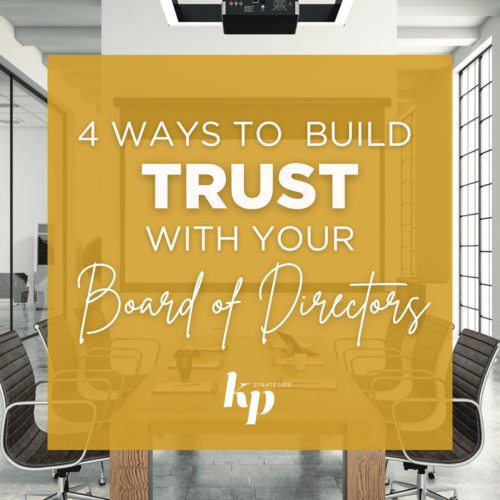A significant 76% of CEOs and executives trust their Boards to engage with shareholders, and 68% trust their Boards to make decisions consistent with the company’s purpose and values, according to a recent PWC report. This level of trust doesn’t just happen—it requires focused and intentional effort from the CEO.
Excellent CEOs concentrate on the following areas to build trust with their Board members:

1. Be Transparent
Great CEOs understand the high cost to themselves and the company if they keep their Board in the dark about critical situations. A good rule of thumb is: when in doubt, share. The best CEOs benefit from such openness—not just by mitigating potential downsides but by creating opportunities for the business. Just like any relationship, transparency is key to establishing trust.
Being open doesn’t mean overwhelming the Board with information. It means sharing both the good and the bad. The best person to start with is the Board Chair. Having a strong relationship and alignment with the Board Chair helps ensure that the real issues are focused on at the right level. The Board Chair can also be an invaluable advisor and mentor for the CEO, providing a sounding board to sharpen the CEO’s thinking. Initiating this relationship is the CEO’s responsibility, not the Board Chair’s.
2. Build a Strong Relationship with the Board Chair
Excellent CEOs spend a tremendous amount of time with their Board Chairs, but they must also invest time with other Board members. When you have ten to twelve Board members with unique perspectives, it’s crucial to manage individuals, not just the group. This is especially important for new CEOs. Each member needs to understand the CEO and vice versa. Great CEOs typically spend time with each Board member once or twice a year.
3. Reach Out to Individual Directors
Giving the Board access to the leadership team is another way to build trust. Allowing the executive team to present at Board meetings provides them with invaluable experience and enables the Board to learn about them. If you have a cohesive Board, they will push back and challenge the executive team—a sign they are doing their job. The CEO’s role is to coach the leadership team and ensure they are prepared. Excellent CEOs also benefit by freeing up significant time and energy when their leadership team presents, allowing them to observe the dynamics of the meeting.
4. Expose the Leadership Team to the Board
Once a foundation of trust is established with Board members, the CEO’s ability to help the Board add more value to the business increases, which is the ultimate goal.
Building trust with your Board of Directors is an ongoing process that requires transparency, strong relationships, individual outreach, and leadership team exposure. By investing time and effort in these areas, CEOs can transform their Boards into valuable assets that contribute to the company’s strategic direction and success. A trusted and engaged Board can provide invaluable insights, challenge management constructively, and help steer the organization toward sustained growth and excellence.